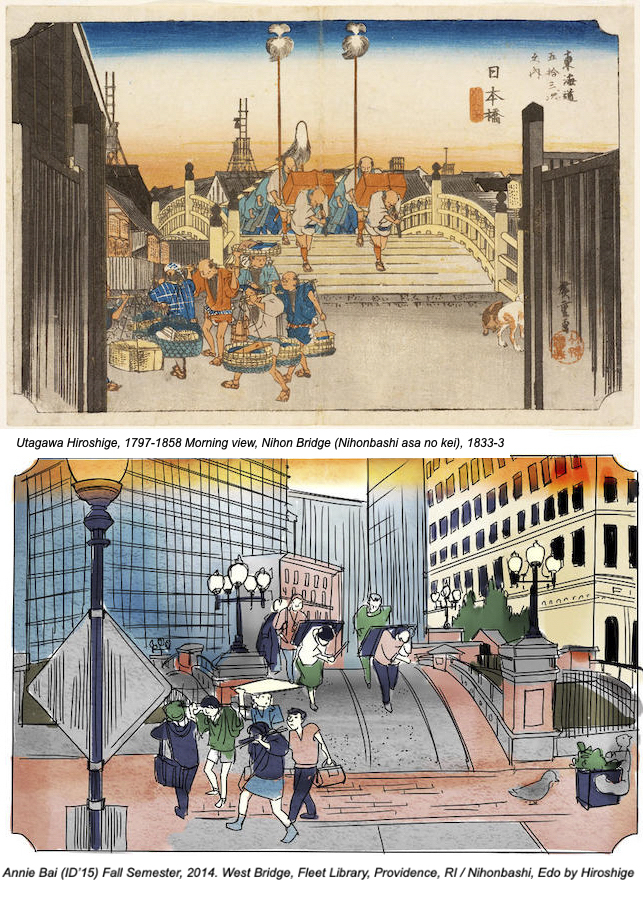
Ukiyo-e Prints Course | Exhibition Catalogs
Files
Download Full Text (18.3 MB)
Description
"Asakusa, a bustling district of Japan’s capital, emerged as a heart of city life during the Edo period (1603-1868). Its popularity continued after Edo was renamed Tokyo in 1868 soon after the beginning of the Meiji era. ...
Thus, Asakusa came to function as a physical and metaphorical path to and site of ukiyo – ‘the floating world,’ an Edo period term, referring to the modern habits and aspirations of townspeople. The notion of ukiyo embraced the lifestyle of city dwellers, their pleasure-seeking, vanity and devotion, intellectual sophistication and playfulness. All this was captured with remarkable exactitude in the ‘pictures of the floating world’ – ukiyo-e, the style of visual art that started in painting but truly developed in the mass-produced medium of woodblock printing.
It was this big theme – Asakusa as the hub of popular culture – that became the focus of inquiry for RISD students of the art history curatorial course Ukiyo-e Prints (H 791) in the fall semester of 2019. Investigating the original ukiyo-e prints from the collection of the RISD Museum, students have selected Keisai Eisen’s triptych Picture of the Kanzeon Thunder Gate at the Kinryuzan Sensoji Temple in Edo, 1828, as the nucleus of their exhibition project. Students then singled out aspects of the culture of the ‘floating world’ that are present in this composition or resonate with it. Accordingly, nine additional prints were chosen for the exhibition project to illustrate the relevant topics.
A challenging task was to elaborate a meaningful layout of the exhibition in which the nucleus print had to hold the central position, while all other were envisioned as displayed radially.
Working in small study groups, students explored all prints in comprehensive essays, discussed their findings in class with their peers, and put together a scholarly catalog. ..." -- Foreword, Asakusa ~ Gateway to the Floating World
Contributing Authors
Barbara Bieniek, Cain Cai, Anna Campbell, Jina Choi, Kaanchi Chopra, Olivia Diamond, Connor Gewirtz, Mary Iorio, Peiqing Jiang, Kalyani Kastor, Roger Li, Emily Mahar, Connor Nguyen, Jacqueline Qiu, Xin Lan Violet Ren, Chenxi Tracy Shi, Song Tan, Cam Unruh, Xiaoben Wang, Yixiao Owen Wang, Jordan Weed, Yuki Xu, Qingyi Yang, Yinan Yang, Yueting Val Zhao
Publication Date
Fall 2019
Techniques
traditional format (bookbinding process), japanese
Instructor
Course
Ukiyo-e Prints (H791)
City
Providence
Keywords
Ukiyo-e prints, “floating world” ukiyo, urban culture, townspeople, bijinga, yakushae, Edo (Tokyo), Keisai Eisen, Okumura Masanobu, Katsukawa Shunzan, Torii Kiyonaga, Utagawa Toyokuni I, Utagawa Toyokuni II (Toyoshige), Utagawa Kuniteru II, Utagawa Hiroshige; Asakusa Temple, Kinryuzan Sensōji Temple, bodhisattva of Mercy Kanzeon (Kannon) Bosatsu (Sanskrit Avalokitesvara), The Thunder Gates Kaminarimon, Yoshiwara brothel quarter, Kabuki theater district, written texts, Sumida River, “inner stores” nakamise, tea houses, fairs, “bustling amusement place” sakariba, collapsible lantern chōchin, governmental Tenpō reforms, book peddler, cosmetic stalls, toothpicks, whitening powder oshiroi, teeth blackening ohaguro, Heian period, poetess Ono no Komachi, sumo wrestling, Kabuki theaters Nakamura-za and Ichimura-za, theater roof structures yagura, Meiji period, jin-rikisha, bento boxes
Disciplines
Art and Design | Japanese Studies | Theory and Criticism
Recommended Citation
Department, Theory & History of Art & Design and Varshavskaya, Elena (H791 Instructor), "Asakusa ~ Gateway to the Floating World (2019)" (2019). Ukiyo-e Prints Course | Exhibition Catalogs. 7.
https://digitalcommons.risd.edu/thad_studentwork_ukiyo-e_prints_exhibitioncatalogs/7

